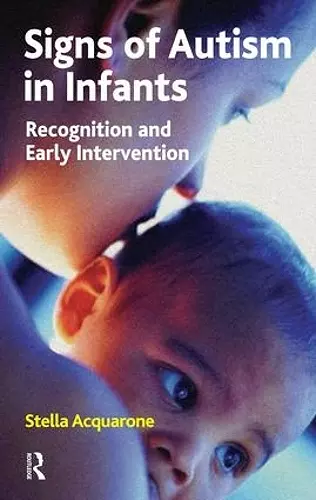Signs of Autism in Infants
Recognition and Early Intervention
Stella Acquarone author Stella Acquarone editor
Format:Paperback
Publisher:Taylor & Francis Ltd
Published:31st Dec '07
Currently unavailable, and unfortunately no date known when it will be back
This paperback is available in another edition too:
- Hardback£125.00(9780367105747)

As a group, babies later diagnosed as autistic are found to have more complications during gestation and delivery than their normal siblings and others. In addition to all these complications, infants later diagnosed on the autistic spectrum have a two-fold rate of residence in neonatal intensive care units. Over the past 50 years, ever younger previously non-viable very low weight babies are being kept alive, some born as much as four months before term. However, it is becoming apparent that miraculous procedures to counteract organ immaturity and prolonged incubation contribute to a new gamut of hitherto unknown forms of neurological damage. With pregnancy curtailed, prematurely separated mothers and their babies both experience a prolonged state of limbo, with the fragile infant being exposed to excruciating medical interventions and overwhelming stimulation.International researchers and clinicians renowned for their work in the field of early autism come together to resolve queries around the long debate on the development and resolution of autism. In this book contributors outline their views on the possibility of preventing the full development of autistic behaviour. They set down clear guidance for professionals in identifying early signs of alarm and offer a model of psychoanalytically informed interventions to treat the pre-autistic infant.
'Theories of autism have undergone many changes since it was originally defined by Kanner as an affective disorder caused by deficient parental interaction. Debates about emotional or organic origins determined subsequent plans of management. Each decade has brought its own contribution to understanding the condition. Since then autism has been identified as a developmental impairment due to a variety of causes which may include genetic, neurological, infectious, metabolic, immunologic and environmental factors, all contributing to atypical brain development, which in turn leads to the autistic child's 'deficient experience of intersubjectivity', as Peter Hobson has defined it. Neonatal research reveals that innate capacities for sociability, self-regulation, thought and language are activated through intensely bi-directional emotional interactions with others, within critical periods. Neonatal research also confirms that even genetic endowment is modified or inhibited by the specific emotional climate of the family environment into which each baby is born. Although the prevention of autism still lies in the future, this book offers hope of alleviating distress through psychodynamic therapeutic work with the family to enhance intersubjective communication and foster the growth potential of the infant. This book brings hope where despair has prevailed. It offers the prospect of early detection of prodromal signs of autism and the possibility of effective therapeutic mitigation of the parents' unbearable predicament of perpetually failing to engage a seemingly unresponsive infant.' - Professor Joan Raphael-Leff, from the Foreword 'This is a very interesting book which will be of value to health professionals, early years' practitioners and other professionals working with young children whose development is a cause for concern.'- Mary Mountstephen, SEN Magazine
ISBN: 9781855754867
Dimensions: unknown
Weight: unknown
298 pages